Viburnum sieboldii
Siebold viburnum
A vigorous deciduous shrub or small tree, up to 6m high, with a stiff, branching habit and ovate to oblong, glossy dark green leaves with impressed veins and toothed edges. Leaves are flushed reddish-bronze when young, and again in autumn, and can give off an unpleasant smell when crushed. In late spring and early summer, clusters of small, white flowers are produced, followed by relatively large, oval shaped pink berries that turn red and then black as they mature
Size
Ultimate height
4–8 metresTime to ultimate height
5–10 yearsUltimate spread
4–8 metresGrowing conditions
Moisture
Moist but well–drainedpH
Acid, Alkaline, NeutralColour & scent
| Stem | Flower | Foliage | Fruit | |
| Spring | White | Green Bronze Red | ||
|---|---|---|---|---|
| Summer | White | Green | ||
| Autumn | Green Bronze Red | Pink Red Black | ||
| Winter | Black |
Position
- Full sun
- Partial shade
Aspect
East–facing or South–facing or West–facing
Exposure
Exposed or Sheltered Hardiness
H6Botanical details
- Family
- Viburnaceae
- Native to GB / Ireland
- No
- Foliage
- Deciduous
- Habit
- Bushy, Spreading branched
- Potentially harmful
- Fruit are ornamental - not to be eaten. Wear gloves and other protective equipment when handling. Pets: Fruit are ornamental, not to be eaten - see the HTA guide to potentially harmful plants for further information and useful contact numbers
- Genus
Viburnum can be deciduous or evergreen shrubs with opposite, simple or palmately lobed leaves and clusters of small, often fragrant white or pink flowers, followed by red, blue or black berries
- Name status
Correct
How to grow
Cultivation
Grow in any moderately fertile, moist but well-drained soil in full sun or part shade
Propagation
Propagate by seed, sown in a cold frame in autumn, by semi-ripe cuttings in summer, or by grafting in late summer or winter
Suggested planting locations and garden types
- Cottage and informal garden
- Wildlife gardens
- Low Maintenance
- Flower borders and beds
Pruning
Minimal pruning required, if necessary prune immediately after flowering, though this will prevent development of berries
Pests
May be susceptible to aphids and viburnum beetle
Diseases
May be susceptible to Phytophthora, honey fungus, grey moulds and leaf spot
Get involved
The Royal Horticultural Society is the UK’s leading gardening charity. We aim to enrich everyone’s life through plants, and make the UK a greener and more beautiful place.
